

Catch Fish with
Mike Ladle
Information Page
SEA FISHING
For anyone unfamiliar with the site always check the FRESHWATER, SALTWATER and TACK-TICS pages. The Saltwater page now extends back as a record of over several years of (mostly) sea fishing and may be a useful guide as to when to fish. The Freshwater stuff is also up to date now. I keep adding to both. These pages are effectively my diary and the latest will usually be about fishing in the previous day or two. As you see I also add the odd piece from my friends and correspondents if I've not been doing much. The Tactics pages which are chiefly 'how I do it' plus a bit of science are also updated regularly and (I think) worth a read (the earlier ones are mostly tackle and 'how to do it' stuff).
Mullet'n bass
This week it was a series of decent spring tides - hopefully just right for attracting maggot-feeding bass and mullet to the shore. The first high water at this time of year falls in the early evening and with any luck there will be three or four more good fishable tides on the following days. Of course 'Sod's Law' operates and if there are no weed middens on the beaches or if the wind is too strong or from the wrong direction, it can put the mockers on any plans we've made. In attempts to predict the best spots to fish my pal Bill and I had tramped miles of shoreline looking for potential fishing spots. By chance we'd gone in opposite directions and although we'd both found piles of maggoty weed they were pretty restricted in extent. This can be bad because it means that there is less food to attract the fish - but it has the advantage of pin-pointing where they are likely to be concentrated.
As it turned out we'd each found a single small pile of weed and they were probably a couple of miles apart along the shore. For our first session we decided to go to 'Bill's pile'; so on the following evening Bill, Nigel and I armed with spinning rods and fly gear(me and Nigel) duly arrived on the shore. As usual I was late, and the other two were already spinning when I arrived. Like me - the fish were slow to turn up but there were seaweed fly maggots floating on the surface and more or less as I arrived a small shoal of thicklips began to skim the surface. Conditions were pretty rough and windy so fly fishing wasn't going to be easy but Nigel was brave enough to make the switch and he picked up his fly rod and baiting the poly-fly with a bunch of wriggling, white maggots he began to cast. Bill and I continued spinning.
It was probably ten minutes or so of tricky casting and removing weed from the line before Nigel's fly rod hooped over to a take. Bill and I put down our rods and began to take a few pictures. To be fair the mullet pulled hard but didn't take a lot of line. The tricky thing was actually getting it onto the beach, because every time it came close another wave broke and the undertow dragged the mullet back out to sea for a further attempt to escape. At least half-a-dozen times the fish repeated it's back and forward surges but eventually, with Bill's help, Nigel slid it up onto the beach and unhooked it to have a picture taken. A cracking, well deserved mullet.
That was more or less that. We fished on for another hour or so but, for no obvious reason, even the small number of mullet dispersed and apart from one missed bite on my fly gear we had nothing else.
Nigel, rod well bent, battles his mullet.
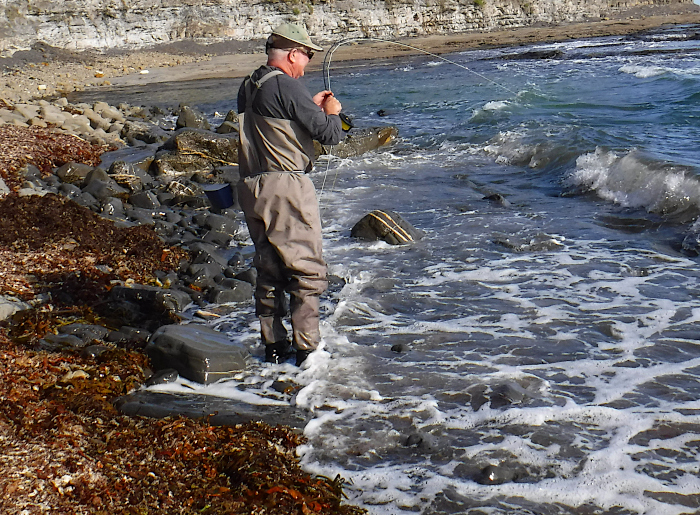
At last, Bill helps the fish ashore.
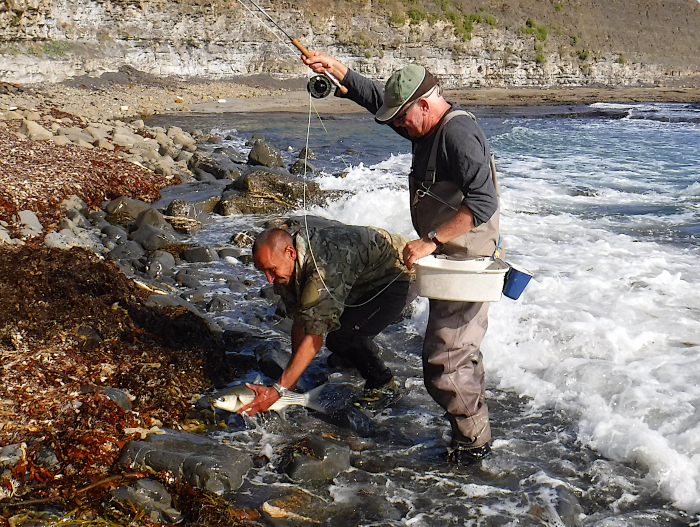
Soft mouthed mullet? I don't think so. Note the (artificial) maggots on the fly.
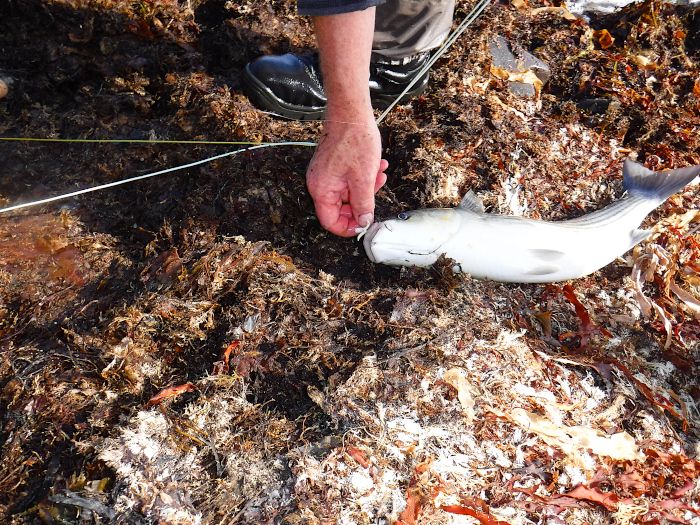
Nice one Nigel (Picture Bill Fagg).
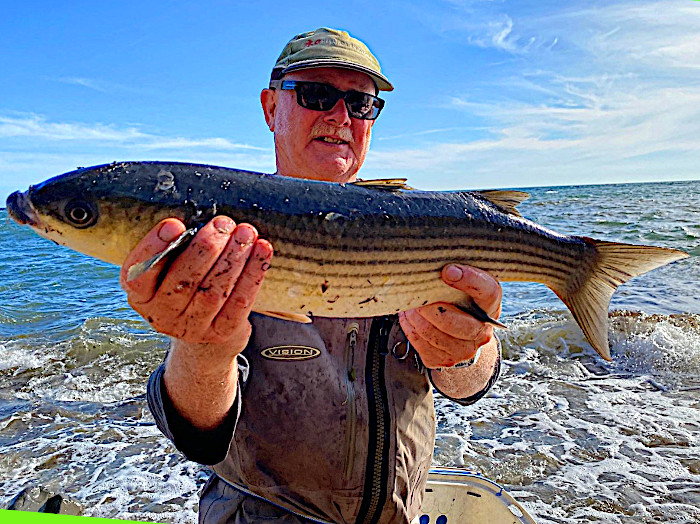
The following day Nigel went, on his own, to the other weed midden which I had seen previously. Apparently it was calmer but few fish turned up and he only managed to land a single smaller mullet on the fly. A couple of days later I'd decided on a dawn sortie to try free-lining a bait for bass. As usual I took the minimum of bait - one sardine and a fillet of mackerel (jeez I'm mean). I hadn't decided exactly where to fish but I knew that it would be the very first of the flood tide. As I walked along the rocks the tide was well out. There was more wind than I'd anticipated, but it would not be a problem to fish. Eventually I found what I had been looking for - a small gully full of 'weed soup'. In fact the tide was on the outer edge of the weed and I was ankle deep in the loose, rather smelly, bits of wrack and kelp. Bending down I could see that there were literally thousands of marine 'woodlice' Idotea creeping about on the weed. Just what the angler ordered.
I baited my size 8/0 circle hook by progging it through the lower jaw and snout of my sardine; then I stood and watched. For a little while nothing happened but the tide was beginning to creep in. I noticed a splash and a ripple at the mouth of the gully and within minutes several fish were moving - they were either swirling at the surface, tailing with their heads down or cruising with just the back and dorsal fins exposed above the water. I flicked the bait out a couple of metres to a point where it was bound to intercept the incoming fish before long. Sure enough there was soon activity in the vicinity of my bait. Now, I know from past experience that a large, free-lined, piece of fish will rest on top of the layer of weed soup. This is the point where I find myself holding my breath and have to consciously make the effort to breathe. The rod is in my right hand and, with the bale arm open, I have the braid between the fingers of my left hand anticipating the twitch or tug that signals a customer. Even though there may be a fair number of fish moving it is not always obvious whether they are bass or mullet (both of them love to eat Idotea) so bites are not a foregone conclusion. It was probably ten minutes before the braid twitched across the surface - the fish took a few centimetres of line, then another metre or so, now the line was running out THEN IT STOPPED. I couldn't believe it had dropped the bait. I waited for a further five minutes but it did not come back. What a downer! The fish were still there but over the next half-hour the amount of activity eased off and I had no further bites. Time to go for breakfast.
I decided that, weather permitting, it would be well worth another go the following morning. On the way home in the car I pondered whether there was anything that I could have done to improve my chances. Perhaps, a smidgeon of groundbait might have helped, and maybe a slightly smaller hook and bait might induce more positive bites? (although I didn't really want to catch small fish). The 'groundbait' was easy, I simply cut the remains of my sardine and bit of mackerel into 2cm pieces using the braid (= bait) scissors. I took another mackerel fillet from the freezer and left it in the car to thaw.
The following morning the tide was forty minutes later, and as I trudged along the shore the sky was already lightening. I arrived at the gully and cut the mackerel fillet in two before baiting up. I'd switched the hook from an 8/0 circle to a 4/0 - just right for a half-size bait. I took the bag of yesterday's 'bait bits' and scattered them in an area where I'd seen lots of activity the day before. This time the sea was glassy calm so I plonked the bait into the scatter of fish pieces, retired a few metres to a handy boulder, sat down and waited.
The sea slowly rose covering one or two small rocks which had been above the surface when I'd started. Fish were beginning to move now. One or two were close to my little, baited patch. A sizable tail wagged above the surface - I'm thinking "That one must be near my bait!". The braid moved and began to tighten, it stopped, it moved again, it stopped again - not my typical bass run. It moved steadily a couple of metres - by now ten or fifteen seconds must have passed since the first incdication of a bite. I decided to close the bale arm and waited, the line drew tight, the rod pulled round, there was a mighty SPLOOSH and the clutch of the old Stradic reel began to screech. It was on! The rod bent and the fish headed for open water. It didn't make it; I pumped in a few metres of line and off it went again, dragging line off the spinning spool. This was repeated eight or ten times. By now I was on my feet and backing away through the shallow, watery, weedy mush. I was now confident that I could land the fish and, sure enough, before long it slipped onto the weed covered beach. Fantastic!
Sixty-two centimetres on my tape and pretty fat, probably about 3kg in weight and in fine nick. Just one problem - where was the hook? Sadly, the bass had swallowed the smaller hook right down its throat - no chance of getting it out, so I would have to take this one as my annual retained bass. I had another cast but to be honest my heart wasn't in it, so I soon packed in and went home. Still, the tactic worked. Must try again (with my big hook?).
Glassy calm and low water. Lots of weed in the foreground. The red dot shows where I placed my baited hook.
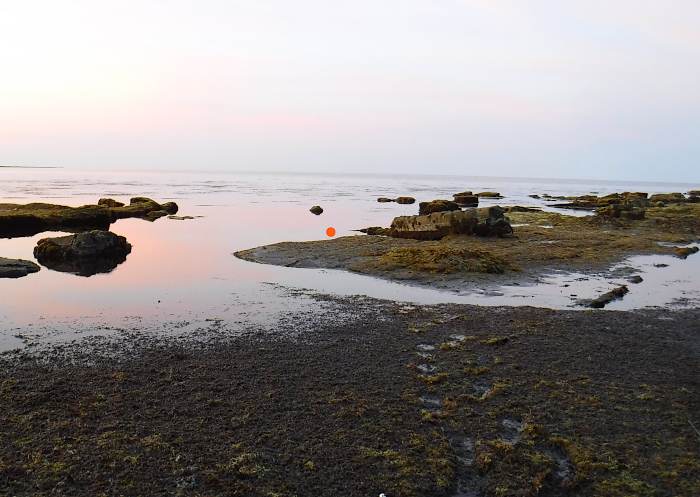
Now I'm sitting on my boulder and the tide is creeping in. The line is just visible..
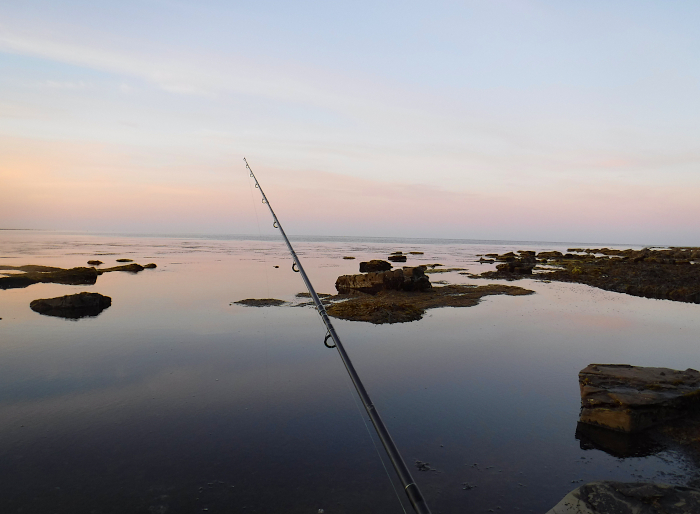
A really nice bass. The half a mackerel fillet had slid up the line.
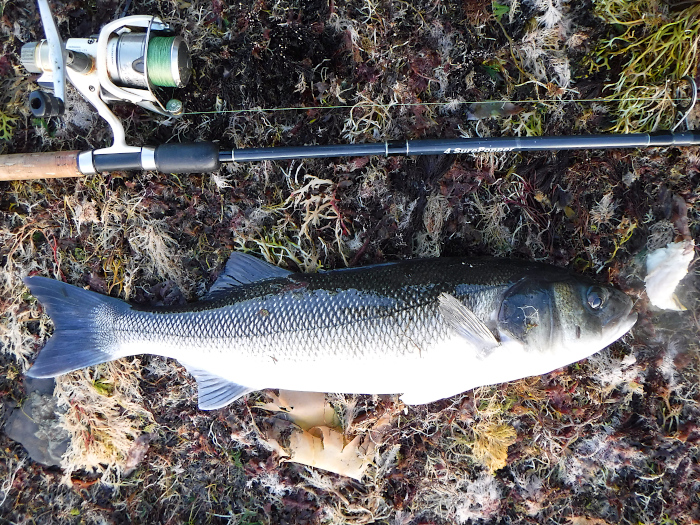
It took me a while to get a selfie - must get myself a little tripod for the camera.
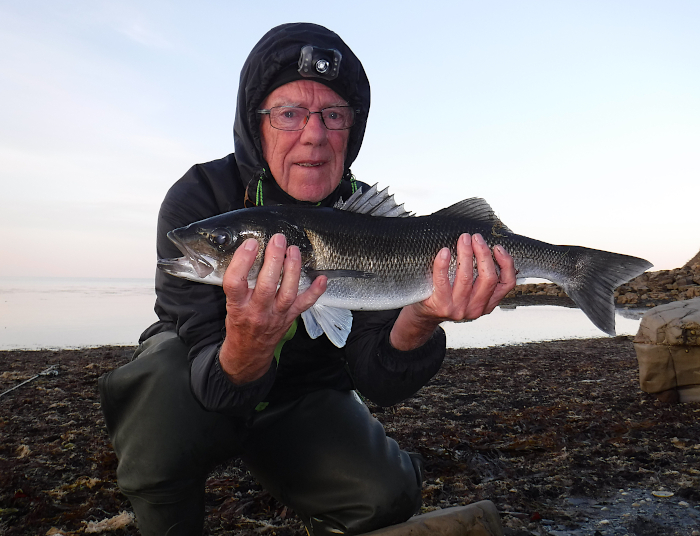
If you have any comments or questions about fish, methods, tactics or 'what have you.'get in touch with me by sending an E-MAIL to - docladle@hotmail.com
– PLEASE TELL YOUR TWITTER, FACEBOOK, EMAIL FRIENDS ABOUT THESE BOOKS.
NEW BOOK
"Fishing for Ghosts - Successful Mullet Angling"
written with David Rigden IT'S AVAILABLE FROM -ALSO THE NEW BOOK
“The Second Wave”
Written with Steve Pitts this is a SEQUEL TO THE BESTSELLER "Operation Sea Angler" IT'S AVAILABLE ON PAPER OR FOR YOUR KINDLE FROM -